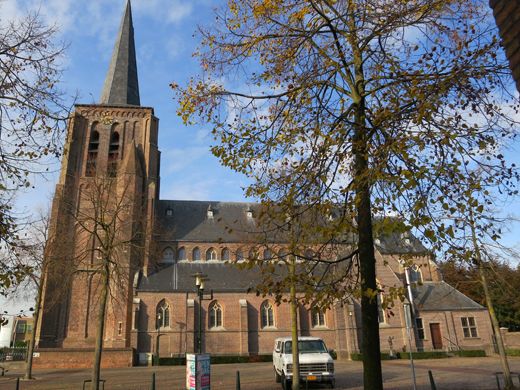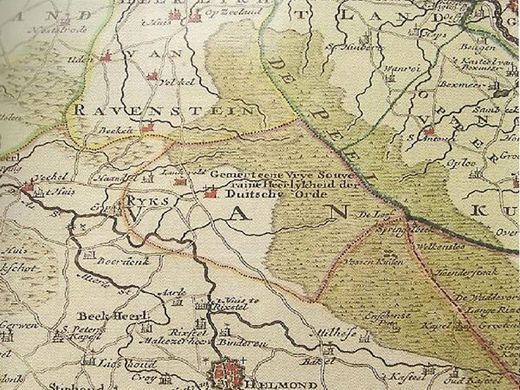Bakel
The oldest village in southern Netherlands
 Bakel is almost the oldest village in the Netherlands but at least the oldest village in Southeast Netherlands. In fact, in 2014 it will officially be 1,300 years old. The first mention dates back to 714 A.D., but Bakel thus existed even earlier. How much earlier is not known.
Bakel is almost the oldest village in the Netherlands but at least the oldest village in Southeast Netherlands. In fact, in 2014 it will officially be 1,300 years old. The first mention dates back to 714 A.D., but Bakel thus existed even earlier. How much earlier is not known.
Bakel was located on the old thoroughfare from Empel to Roermond on a road also called the Oudestraat (prehistoric route Empel-Roermond). The oldest written mention dates from the year 714, when a charter was drawn up for the Frankish mayor Pippin II in his residence in Bakel ("Bagoloso" at that time). This early-medieval royal residence has not yet been located archaeologically. A charter from 721 speaks of the possessions of the Frankish nobleman Herelaef, whose mother had possessions at Bakel (Baclaos). In that year Herelaef donated to Willibrordus, among other things, a church at Bakel. Through Willibrordus, this church came into the possession of the Abbey of Echternach, which would continue to have influence in Bakel until 1795. The authenticity of the original documents, the originals of which had generally been lost by the 11th century, is doubtful. They rest on the Liber Aureus written by interested monks.
Before 721, a wooden church was built in Bakel, which was replaced by a stone Romanesque church around 1100. This was in turn replaced by the present, Gothic, church. The parish church of Bakel was the mother church for the inhabitants of Deurne, Gemert and Milheeze.
Several successive popes ratified the rights of the Abbey of Echternach. Around 1100, the possessions of this abbey were administered by a laatbank established in nearby Deurne.
In the subsequent period, feudal lords began to exhibit increasing power. Around 1200 Bakel fell under the County of Rode which was under the influence of the Count of Gelre. William I of Horne owned the guardianship of the goods of the Abbey of Echternach in Peelland and transferred them to Duke Henry I of Brabant in 1222. However, the cijns' right was shared between duke and abbey. However, the abbey reissued the tithe right to local notables.
In 1648, Bakel came directly under the Republic of the Seven United Netherlands and the practice of the Catholic religion was prohibited. From 1672-1674, the region was occupied by French troops. Barn churches could be built from then on, and the Bakel barn church remained in use until 1818, after which the Catholics regained their original church.
Bakel has something unique with the Stippelberg Golf Course
 The golf course consists of an 18 hole golf course; a 9 hole par 3/4 course and extensive practice facilities. The clubhouse has a spacious public restaurant with a large terrace from which there is a beautiful view of the golf course. The 18-hole Championship Course (length 6088 meters) features rich native vegetation. Its smaller sister, the 9-hole Executive Course (length 1913 meters) consists of five par 3 and four par 4 holes.
The golf course consists of an 18 hole golf course; a 9 hole par 3/4 course and extensive practice facilities. The clubhouse has a spacious public restaurant with a large terrace from which there is a beautiful view of the golf course. The 18-hole Championship Course (length 6088 meters) features rich native vegetation. Its smaller sister, the 9-hole Executive Course (length 1913 meters) consists of five par 3 and four par 4 holes.
The Gemert-Bakel Golf Championships have been held annually since 2001. This is organized by a number of enthusiastic golfers from the municipality of Gemert-Bakel. The interest in this event is still overwhelming. In recent years there has even been an oversubscription of participants. On De Stippelberg estate you will find forests, sand drifts, heathland and stately lanes. In the west there are old drifting dunes like 'dots' in the landscape. This is what gives the nature reserve its name. Heath dominated until the end of the nineteenth century, but from 1893 to 1935 the Heidemaatschappij turned the area to its own will; where heather and gorse once grew, Douglas fir and Japanese larch emerged. In the area, with an impressive 1000 hectares, you will find peace and quiet. In spring fresh green colors dominate, in autumn the trees turn soft yellow to burgundy.
On De Stippelberg estate you will find forests, sand drifts, heathland and stately lanes. In the west there are old drifting dunes like 'dots' in the landscape. This is what gives the nature reserve its name. Heath dominated until the end of the nineteenth century, but from 1893 to 1935 the Heidemaatschappij turned the area to its own will; where heather and gorse once grew, Douglas fir and Japanese larch emerged. In the area, with an impressive 1000 hectares, you will find peace and quiet. In spring fresh green colors dominate, in autumn the trees turn soft yellow to burgundy.
www.golfbaan-stippelberg.com
 The Heerlijckheid Gemert-Bakel consists of 7 Church villages. Gemert, Bakel, De Mortel, Handel, Elsendorp, De Rips and Milheeze. Each village has its own rich history. Each village here is unique. Click here for a short introductory film about Gemert-Bakel:'Kom ook naar Gemert-Bakel'. It is definitely worthwhile to come and visit the church villages. For a day out, a weekend trip or an overnight stay in nature. In Gemert-Bakel there is plenty for adults and children to see, do and experience.
The Heerlijckheid Gemert-Bakel consists of 7 Church villages. Gemert, Bakel, De Mortel, Handel, Elsendorp, De Rips and Milheeze. Each village has its own rich history. Each village here is unique. Click here for a short introductory film about Gemert-Bakel:'Kom ook naar Gemert-Bakel'. It is definitely worthwhile to come and visit the church villages. For a day out, a weekend trip or an overnight stay in nature. In Gemert-Bakel there is plenty for adults and children to see, do and experience.





